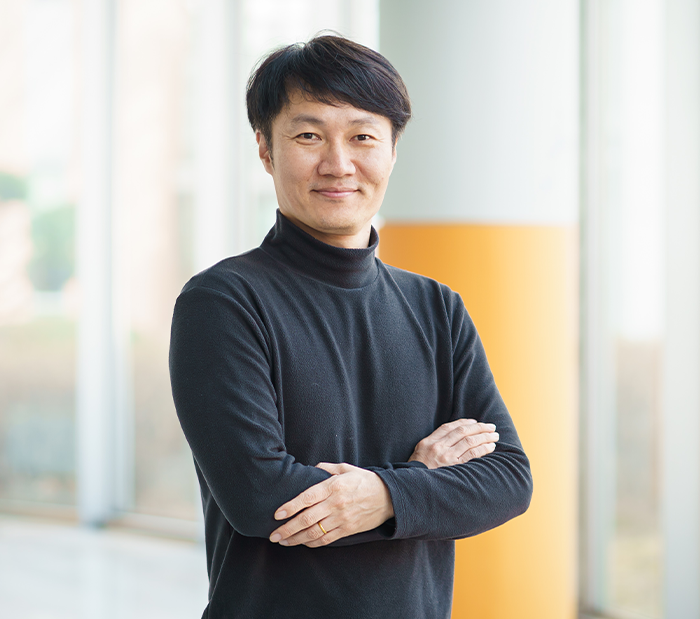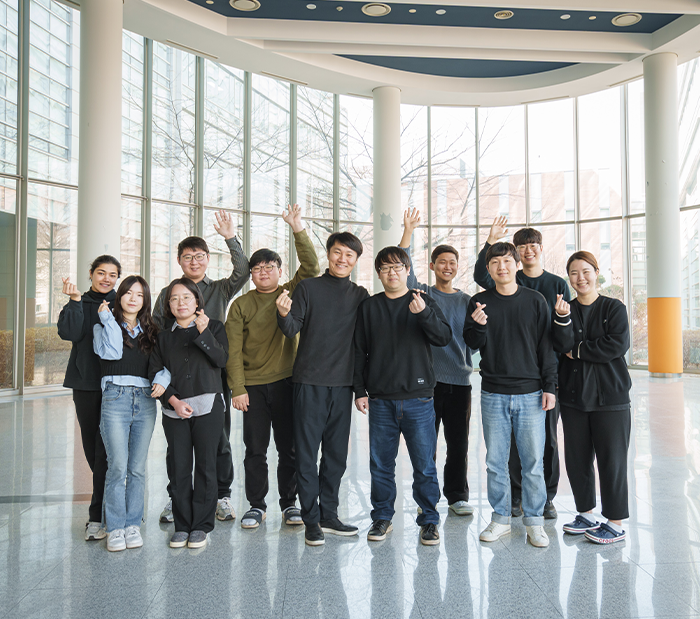Research Stories
The research team led by Prof. Sungho Park
A new way to confine electromagnetic near-field within a single entity
- Successive publications in top-tier scientific journals in the disciplines of chemistry and nanomaterials
- Structurally unique and complex nanoframes can replace conventional nanoparticles in plasmonics, biosensing, and catalysis
Chemistry
Prof.
PARK, SUNGHO
Noble metals such as Au and Ag exhibit unique optical properties when their sizes are smaller than the wavelength of light. Surface plasmon resonance, a collective oscillation of conduction free electrons of metallic nanoparticles, is very sensitive to size, shape and dielectric environment and supports strong localized near-field confinement around the metallic nanoparticles. These plasmonic nanoparticles have been widely applied in a myriad of applications including optics, biosensing, catalysis and energy.
Although structural-simple nanospheres or nanorods have been extensively used because of their easy-to-use, weak near-field focusing capabilities hindered their effective use for practical applications. In addition, nanoframes that have recently been paid attention show certain limitations in that their large inner spaces do not allow effective interactions with resonant light. Importantly, it is very challenging to produce nanoparticles with uniform size and shape via wet-chemical synthesis because diverse particle-particle interactions are present in a solution-phase.
The research team (Nanomaterials Chemistry Lab.) led by Prof. Sungho Park in the department of chemistry, came up with a new idea inspired by ‘Cosmic Bowl*’ and ‘Matryoshka Doll**’and developed a new synthetic method for structurally very complex nanoframes that exhibit strongly enhanced near-field focusing capability. By suggesting a new paradigm in the field of nanoparticle synthesis, the research team’s breakthrough has been appreciated.
The team applied rationally-designed multiple chemical steps and realized structural-complex nanoframes with different shapes, sizes, and numbers of nanogaps in a single entity. Importantly, the synthesis method is “rational and on-demand that is different from the conventional “trial-and-error” method, allowing for developing a broad library of unique nanoframes including dimensions (2D, and 3D), order (numbers of frames: 1st, 2nd, 3rd, and 4th), composition (Au, Pt, and Ag), shapes (circular, triangular, hexagonal, cubic, and octahedron), nanogaps shapes (circular, triangular, Y-shape)
Using these nanoframes as a building block, the team fabricated superlattice substrates with uniform arrangement and high sensitivity. Their strong plasmonic interactions from inter- and intraparticle coupling allow for a very sensitive SERS-based detection of target molecules and reached pico and attomolar levels of limit of detection.
Prof. Sungho Park said, “I am really happy and excited that we developed a new synthetic pathway for designing complex nanoframes that had never been reported before. We believe it is an important step towards new breakthroughs in nanoparticle synthesis and will use nanoframe-based libraries for diverse applications such as chemical/biological sensing, catalysis, plasmonics and energy storage where strong electromagnetic near-field enhancement is important.”
This research was supported by the Challengeable Future Defense Technology Research and Development Program through the Agency for Defense Development (ADD) funded by the Defense Acquisition Program Administration (DAPA) in 2022. The results were published in various top-tier journals in the chemistry and materials science discipline, proving the scientific importance. (Nature Communications, Journal of the American Chemical Society, Accounts of Chemical Research, ACS Nano, Nano Letters, etc.)
*(Title : Plasmonic All-Frame-Faceted Octahedral Nanoframes with Eight Engraved Y-Shaped Hot Zones, 제 1저자 : 김정원, 저널명 : ACS Nano (IF:18.027), 게재일 : 2022년 6월 28일)
*(Title : All-Hot-Spot Bulk SERS substrates: Attomolar Detection of Adsorbates with Designer Plasmonic Nanoparticles, 제 1저자 : Qiang Zhao, 저널명 : Journal of American Chemical Society (IF:16.383), 게재일 : 2022년 7월 27일)
*(Title : Three-dimensional Nanoframes with Dual Rims as Nanoprobes for Biosensing, 제 1저자 : Hajir Hilal, 저널명 : Nature Communications (IF:17.694), 게재일 : 2022년 8월 16일)
*(Title : Synthesis of Pt Double-Walled Nanoframes with Well-Defined and Controllable Facets, 제 1저자 : MohammadNavid Haddadnezhad, 저널명 : ACS Nano (IF:18.027), 게재일 : 2022년 12월 27일)
*(Title: Multi-Layered PtAu Nanoframes and their Light-Enhanced Electrocatalytic Activity via Plasmonic Hot Spots, 제 1저자 : 이수현 저널명 : Small (IF:15.153), 게재일 : 2023년 1월 8일)
*(Title : Multiple Stepwise Synthetic Pathways toward Complex Plasmonic 2D and 3D Nanoframes for Generation of Electromagnetic Hot Zones in a Single Entity, 제 1저자 : 정인섭, 저널명 : Accounts of Chemical Research (IF:24.466), 게재일 : 2023년 2월 7일)
*Cosmic Bowl: German mathematician and astronomer, Johannes Kepler proposed the concept of ‘Cosmic Bowl’ that the universe is interconnected by planets comprised of five platonic polygons nesting one in another.
**Matryoshka Doll: A set of wooden dolls of decreasing size are nested one inside another and are known as Russian dolls.
※ Title : Multiple Stepwise Synthetic Pathways toward Complex Plasmonic 2D and 3D Nanoframes for Generation of Electromagnetic Hot Zones in a Single Entity (DOI: https://doi.org/10.1021/acs.accounts.2c00670)
[Figure 1. 다단계의 2차원 복잡 구조 나노프레임 합성 모식도]
[Figure 2. 이중-림을 가지는 나노프레임 합성법, 제작된 입자의 주사전자현미경 이미지 및 균일한 자가조립 기판의 극대화된 전자기장 증강 효과 시뮬레이션][Figure 3. 금 나노입자 결정면의 에너지 차이를 이용한 선택적 백금 증착 및 금 에칭 기법을 활용하여 다양한 모양을 가지는 백금 기반의 단일 또는 이중림 구조 나노프레임 입자의 이미지]
[Accounts of Chemical Research Journal, Feb. Supplementary cover]
[ACS Nano Journal 2022 June Front cover]


